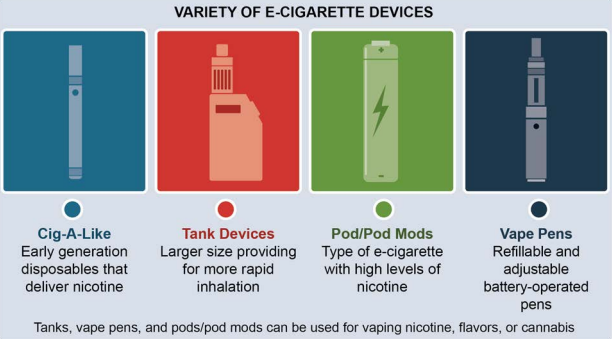Vaping Information
What Is Vaping?
Vaping refers to the use of any device, such as an electronic cigarette, or e-cigarette, which fundamentally heats a liquid solution into an aerosol that is inhaled into the lungs of the person using it. Some vape devices resemble pens, USB sticks, and other everyday items. Larger devices such as tank systems, or “mods,” do not resemble other tobacco products.
Why Does It Matter?
Most vapes contain nicotine, which is highly addictive and can harm the developing adolescent brain. The nicotine in e-cigarettes and other tobacco products can also prime young brains for addiction to other drugs, such as cocaine and methamphetamine. Some vapes that have been marketed as not containing nicotine have been proven to still contain it.
In addition, a variety of substances that are known to be toxic, carcinogenic, or disease-causing have been identified in vaping liquid solutions and aerosols, including delivery solvents, flavorings, carbonyl compounds, minor tobacco alkaloids, tobacco-specific nitrosamines, reactive oxygen species, metals, and other toxicants.
Also, vape juice can be altered, or self-made. This means the consumer may not be aware of what they are actually inhaling. For example, vapes can contain Tetrahydrocannabinol (THC), the substance most commonly found in marijuana, as well as a variety of other substances.
Are They Safer Than Cigarettes?
Regular cigarettes are extraordinarily dangerous, killing half of all people who smoke long-term. However, youth use of tobacco products in any form is unsafe, including vapes. More research is needed to fully understand their impact on health.
It Is Illegal To Sell Vapes To Teens, So How Do They Get Them?
Even though the federal laws limits the sale of nicotine vapes to consumers 21 years of age or older, teens get access to them by borrowing, buying them from another person, giving money to someone to buy for them, or receiving it as a gift from a friend or family member.
The Good News Is That Most Teens Don't Vape
Studies show that in 2019 the majority of high school students did not vape. Even more said they did not vape, or did not vape on a regular basis.
For Young People
- Nicotine, often found in vapes, is a stimulant. Nicotine increase your heart rate, tenses your muscles, and decreases oxygen to your brain.
- People who don't vape can cope with stress better and are more resilient.
- Going vapeless can save you up to $1500 a year! This would cover the cost of a new gaming console, a huge shopping spree, could go towards buying a car, a lifetime fishing license with the gear to go with it, or several other fun items and activities!
- One of the main reasons people vape is stress. Stress is real, and can be difficult to overcome. Here are some healthy ways to cope with stress:
- Exercise
- Talk it out- talk with friends or family
- Make time for fun…or quiet
- Get outside
- Write about it in a journal
- Explore Mindfulness activities like this one:
Parents, This One's For You
Here are some tips from the American Lung Association to talk with your teens about vaping:
- Know the facts: misinformation about vaping is everywhere. Two-thirds of teens don’t even realize that e-cigarettes contain addictive nicotine. Before the conversation, get comfortable with the key dangers and potential motivations for kids to vape. You may not feel like an expert, and that’s okay. Expressing care and concern is one of the best ways to support your child.
- Put yourself in your child’s shoes: consider your kid’s viewpoint. Imagine the obstacles, pressures and social environment before you address your concerns. Remember what it was like when you were a kid. Make sure to relate to them. Remind them that you’re on their side. When empathy is expressed and good communication exists, kids take fewer risks.
- Take an open and calm approach: as you talk to your child, avoid judgment or frustration. Kids may pick up on your tone and tune out or react defensively. An open conversation will disarm the notion that this is a lecture. It will also provide a relaxed environment to discuss ideas without making them feel like they are being blamed or in trouble.
- Find the right time and place: wait for the right opportunity to increase the chance that you are heard. Maybe you’re passing a vape shop, watching TV together, or talking before your child goes to a concert with friends. Pick a calm moment that is distraction free. Asking your child about vaping when it is already on their mind gives you a non-confrontational way to learn about your child’s awareness, interest and involvement without defensiveness.
- Take time to practice: for important and potentially difficult conversations like these, it’s helpful to know exactly what you’d like to say before you say it. Take time in front of the mirror or with a partner to run through the points that you feel are most important. Consider how your child will react to the information. Try to anticipate how the conversation may go, and come prepared to respond calmly to any situation.
- For more information on vaping from the American Lung Association, please visit:
If You Or Someone You Know Is Struggling To Quit Vaping
HELP4WV is a 24/7 service that connects people struggling with mental health or addiction. They can be reached by calling (844) 435-7498 or texting (844) 435-7498 or at this site:
You can also find additional resources for families and youth here on our website:
Sources
- American Psychological Association (APA) article: https://www.apa.org/topics/children/stress
- Alabama A&M and Auburn Universities Extension article: https://www.aces.edu/blog/topics/health/the-cost-of-vaping/
- Centers for Disease Control and Prevention (CDC): https://www.cdc.gov/tobacco/basic_information/e-cigarettes/index.htm
- Food and Drug Administration (FDA): https://www.fda.gov/tobacco-products/products-ingredients-components/e-cigarettes-vapes-and-other-electronic-nicotine-delivery-systems-ends
- Substance Abuse and Mental Health Services Administration (SAMHSA): https://www.samhsa.gov/resource/ebp/reducing-vaping-among-youth-young-adults

